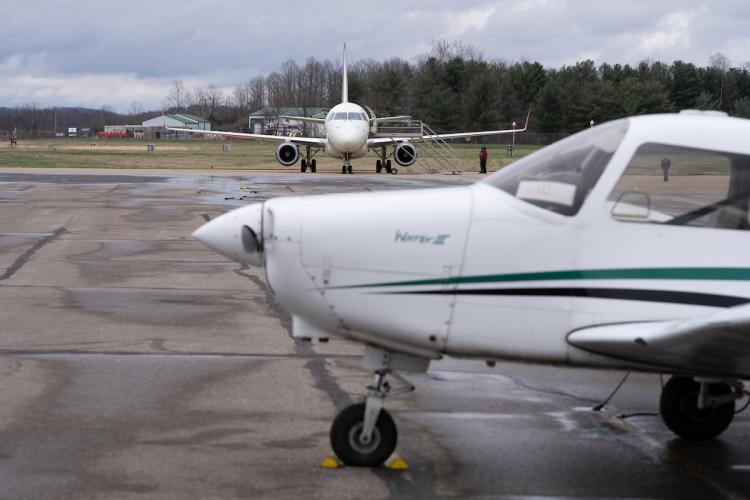
Ohio University awarded grant to promote air mobility in Appalachia

A rapidly developing new generation of electrically-powered advanced aircraft is expected to soon provide new means of aviation services, from package delivery to emergency medicine to personal transportation. While much attention has been focused on their use in cities, there are many opportunities for well-prepared rural communities as well.
Ohio University and the Ohio Department of Transportation are working to help Appalachian communities to be prepared. The University's Voinovich School of Leadership and Public Service was awarded a grant for $50,000 by the Appalachian Regional Commission (ARC) to help advance and promote innovative air mobility uses in Ohio’s Appalachian Region. OHIO’s Voinovich School of Leadership and Public Service will partner with FlyOhio and JobsOhio to explore Advanced Air Mobility (AAM) opportunities for the region’s business, transportation, medical and logistical needs.
Leading the project from OHIO includes Russ College of Engineering and Technology Associate Professor Jay Wilhelm and Voinovich School of Leadership and Public Service Professor of Rural Economic Development Jason Jolley.
OHIO also matched the grant to help provide funding for the 12-month project and will partner with four local development districts to identify potential AAM applications. The team will engage community stakeholders, conduct research and analysis, and prepare a report to document the strategy.
At the end of the project, researchers from the three organizations will have a documented economic development strategy, including the development of local case studies and a report looking at the way new entrepreneurial activities can be created due to AAM.
“I’m excited to see all the possibilities that are out there with these new forms of aviation,” Brent Lane, an executive in residence at OHIO’s Voinovich School who focuses on economic development and is assisting on the project, said. “The ease of use and expansion of access that we may be able to experience in the next 10-20 years due to this innovation in transportation could be life changing, especially to those in rural areas like Southeastern Ohio.”
The region already has a significant aviation capability to build upon. According to Lane, there are 27 general aviation airports in the 32 Appalachian counties actively supporting commercial, personal, government, and business use. Capitalizing on next-generation aviation would leverage these airports for new economic and community development beneficial to rural Ohio.
“By using this technology and existing infrastructure, distance can be taken out of the equation as a limitation. This type of technology can shorten people’s commutes, provide them with easier access to urban areas and overall allow more people to participate more readily throughout the region,” Lane said. “This is exceptionally important for those in rural areas of Appalachia who don’t currently have the benefit of working with or in commercial areas more often found in urban settings.”
The focus of bringing AAM technology to rural areas like Southeastern Ohio is for a variety of uses such as moving both people and cargo, making deliveries, and perhaps most importantly, for emergency medical services. The AAM technology will open new applications in a way that can help underserved regions and foster economic growth.
Looking specifically at the healthcare industry, populations are spread out across the region but having access to these modes of transportation makes organ donation, blood transfusion supplies, and many more necessary medical care more affordable and efficient. The researchers’ goal for this technology is to fill gaps in the healthcare system, among other fields.
“Air ambulance services cost tens of thousands of dollars and are limited depending on where you’re located, but with AAM, there is the opportunity for better and more affordable medical services across the Appalachian region,” Lane explained. “This type of technology would be more affordable in getting people to hospitals faster, with the potential to be stationed in more areas allowing for easier access across the region.”
In addition to the potential health benefits, this new technology can also make rural areas more integrated with other state economies too. Businesses located in rural areas can use this technology to deliver cargo and goods well outside their direct region. This can have a significant economic impact and allows for these businesses to continue to live and grow in their respective area without having to move closer to metro areas.
The initial stages of research include communicating the state of the technology to key economic developers and local government officials, looking at the economic potential and getting feedback from communities on what their priorities and needs are before implementing the actual technology.
“As a state, our FlyOhio initiative is planning for the next stages of air mobility,” Rich Granger, Managing Director of Workforce at DriveOhio, said. “With this statewide opportunity, there is a great chance for Appalachian Ohio to have a seat at the table from the very beginning and to be a leader in this new innovation. This collaboration allows us to develop a toolkit that becomes guidance for further planning and implementation.”
Granger also explained that Ohio has released the nation’s first AAM statewide framework, developed by the Ohio Department of Transportation, through DriveOhio, the state’s smart mobility hub. This framework positions Ohio for advanced aviation growth throughout the state and is well aligned with the ARC planning grant.
“The future is already here, and we want to be one of the firsts to welcome and utilize this technology,” Lane said. “Often, advancements in technology come to rural areas last, but we are positioning ourselves to be the innovators and to be leaders in the state of Ohio.”
